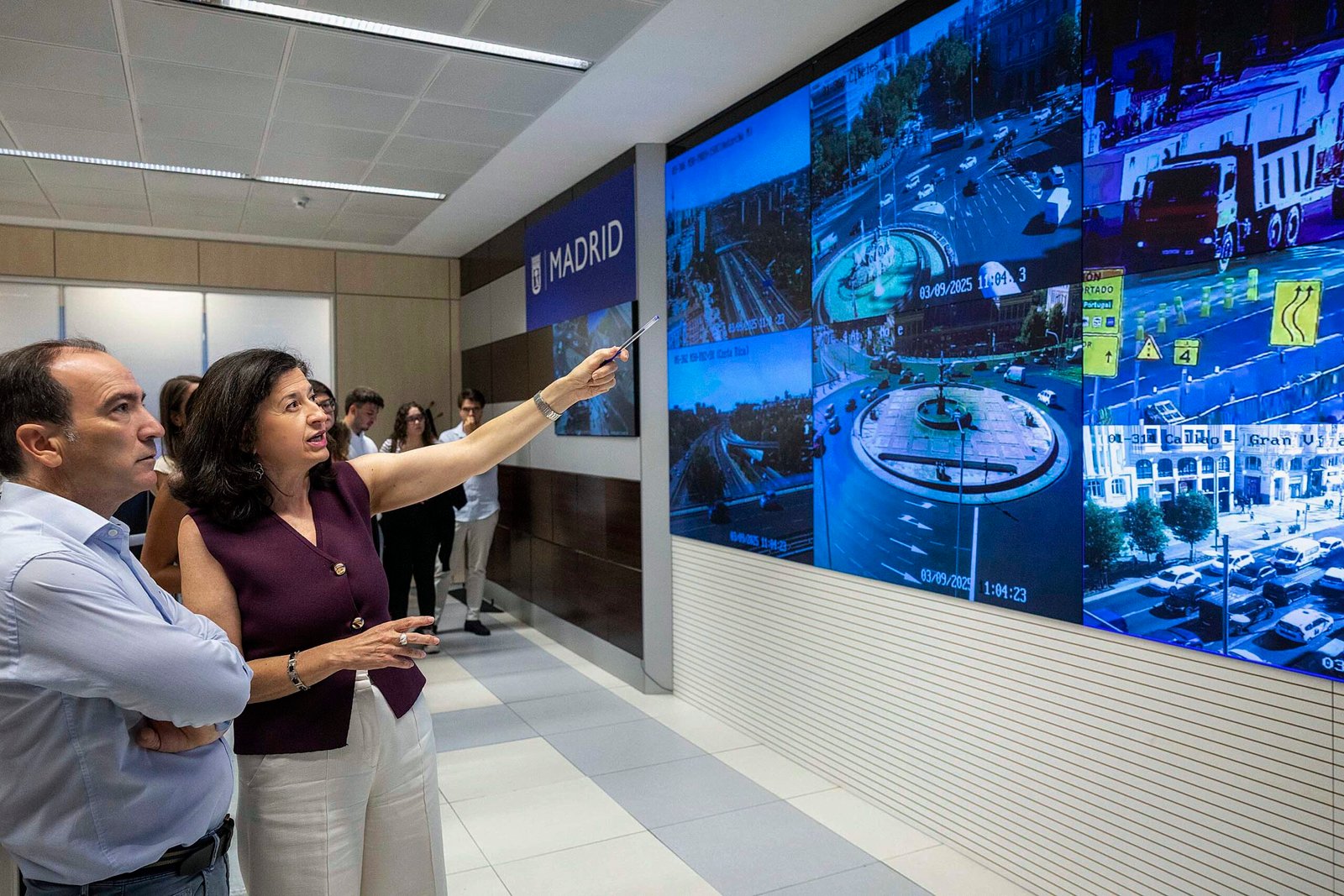The vice mayor of Madrid, Inma Sanz, accompanied by the delegate for Social Policies, Family, and Equality, José Fernández, and the councilor of Moncloa-Aravaca, Borja Fanjul, has conducted an assessment of the process of digitization of the Advanced Teleassistance of the City of Madrid at the Municipal Center for Elderly Infante Don Juan. More than 150,000 users benefited from this municipal service in 2024, and the City Council is incorporating cutting-edge technological solutions that reinforce the objective of this provision: to offer professional support that empowers people over 65 and under that age with recognized dependence to remain in their homes for as long as possible in conditions of tranquility, safety, and autonomy.
The evolution of Teleassistance began in the summer of 2023, following the approval of the new management contract for this service, endowed with a multi-year expenditure of 128 million euros. This contract aimed to provide users with new digital devices that would improve their quality of life and promote active longevity. Each user can choose the Teleassistance device that best suits their needs. More than 98,000 people still use the traditional pendant (red button), but others have opted for more innovative models such as the smartwatch with SOS button and geolocation, which allows the service to work outside the home and of which more than 3,000 units have been delivered (as of February 2025). Additionally, 24,200 people have bracelets that combine the functionality of the medallion and fall detection sensor.
Gas and smoke detectors and sensors that detect routines
The Advanced Teleassistance of the City Council also offers the possibility of installing different devices in homes that can sound the alarm in case of an emergency, thus reinforcing the feeling of security for both users and their families and caregivers. In this regard, over 18,000 devices have been installed, including 12,600 smoke detectors and 5,000 gas detectors. Additionally, 487 people have routine and behavior pattern detectors in their homes, placed in areas like bedroom doors or refrigerators, triggering an alert if the user has not gotten up or has not performed an important task like going to the kitchen or bathroom.
Equipment adapted for users with disabilities has been offered. In fact, 1,139 devices have been provided to ensure the accessibility of the service (terminals activated by voice or blowing, adapters for buttons with increased sensitivity, smart lighting, inductive loop, and phones with large keys, among others). Furthermore, 23 remote door opening devices have been installed, providing a safe alternative for people with reduced mobility, and 180 people benefit from telemonitoring of vital signs and medication dispensers (through calls and videoconferencing).
Evolution from analog to digital terminals
To carry out such a significant transformation in teleassistance, it was necessary to replace the old analog terminals that serve as the service’s base with new digital terminals that offer numerous advantages: increased connectivity, advanced features, real-time monitoring, and remote updates. From July 2023 to February 2025, 73,000 analog terminals have been replaced with digital ones, jointly funded by the City of Madrid and the Community of Madrid. The City Council continues to work on replacing the more than 30,000 analog bases still in operation (only one per household is required, so some users share it).
The Advanced Teleassistance is a social care and personalized support service, which also includes programs and protocols aimed at ensuring the well-being of users such as mental health, grief, prevention of cognitive decline, unwanted loneliness, or suicide. Being a 24-hour service, it can provide an adequate response to the social, lonely, or emergency needs of users, including the mobilization of health and social resources if necessary. Additionally, through this resource, users are alerted to risky situations such as cold or heat waves.
More than 5.2 million calls in 2024
During 2024, professionals from the Advanced Teleassistance service made over 4 million control calls and answered 1.2 million calls from users. Last year also saw more than 225,000 home support trips for emergency situations, and over 35,000 follow-up, counseling, and psychosocial intervention visits.
In 2024, over 150,000 different individuals benefited from the service. The majority profile of users is women (73%) over 80 years old with a slight social risk, half of whom live alone. According to last year’s satisfaction survey, users rated the Advanced Teleassistance service of the City of Madrid an average of 9.5 out of 10. 90% feel safer with this service, and 73% acknowledge that it has helped them stay in their homes.
Additionally, the Area of Social Policies, Family, and Equality has aimed to bring this resource to homeless individuals. Specifically, in 2024, a pilot project was launched where Advanced Teleassistance devices were provided to seven users at the San Isidro Shelter, who received support in acquiring the necessary routines for the proper functioning of the equipment. The experience has been very positive, as users have been able to alert about falls on the street and remember appointments through the system.
Free service for individuals over 88 years old
In compliance with the government program, the City Council established in January 2024 the free provision of Advanced Teleassistance to individuals over 90 years old, extending the cost-free service to those over 88 years old in January 2025. With this measure, over 27,700 individuals do not pay for this municipal service and save between 72 and 144 euros annually, depending on their income. They are joined by 56,800 individuals who are also exempt from the fee because their income level is below 614.30 euros per month, ensuring that their vulnerability does not hinder their access to this resource.
To request the Advanced Teleassistance service, interested parties can call 010 or the senior’s phone (900 111 065), or go in person to the social services center that corresponds to them. /
FUENTE



